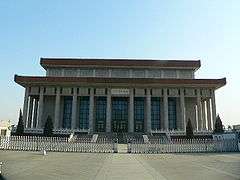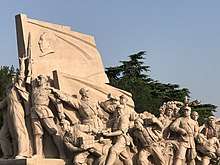Mausoleum of Mao Zedong
The Chairman Mao Memorial Hall (simplified Chinese: 毛主席纪念堂; traditional Chinese: 毛主席紀念堂; pinyin: Máo Zhǔxí Jìniàn Táng), commonly known as the Mausoleum of Mao Zedong, is the final resting place of Mao Zedong, Chairman of the Politburo of the Communist Party of China from 1943 and the Chairman of the Communist Party of China from 1945 until his death in 1976.
| Mausoleum of Mao Zedong | |
|---|---|
毛主席纪念堂 | |
 Mausoleum of Mao Zedong | |

| |
| Alternative names | Chairman Mao Memorial Hall |
| General information | |
| Type | Mausoleum |
| Location | Tiananmen Square |
| Town or city | Beijing |
| Country | China |
| Coordinates | 39°54′04″N 116°23′29″E |
| Named for | Mao Zedong |
| Groundbreaking | November 24, 1976 |
| Completed | May 24, 1977 |
| Renovated | 1997-98 |
| Known for | Final resting place of Mao Zedong |
Although Mao had wished to be cremated, his wishes were ignored and his body was embalmed. The construction of a mausoleum as his final resting place began shortly after his death. This highly popular attraction is located in the middle of Tiananmen Square in Beijing. It stands on the previous site of the Gate of China, the southern (main) gate of the Imperial City during the Ming and Qing dynasties.
The embalmed body of Chairman is preserved in the cooler, central hall of the mausoleum in a glass case with dim lighting; it is guarded by a military honor guard. The mausoleum is open to the public every day except Mondays.[1]
History

The mausoleum was built soon after Mao's death on September 9, 1976. The groundbreaking ceremony took place November 24, 1976, and the mausoleum was completed on May 24, 1977. Chairman Hua Guofeng, who supervised the mausoleum project, has his handwriting on the mausoleum's sign.
People throughout China were involved in the design and construction of the mausoleum, with 700,000 people from different provinces, autonomous regions, and nationalities doing symbolic voluntary labor.[2] Materials from all over China were used throughout the building: granite from Sichuan province, porcelain plates from Guangdong province, pine trees from Yan'an in Shaanxi province, saw-wort seeds from the Tian Shan mountains in the Xinjiang Autonomous Region, earth from quake-stricken Tangshan, colored pebbles from Nanjing, milky quartz from the Kunlun Mountains, pine logs from Jiangxi province, and rock samples from Mount Everest. Water and sand from the Taiwan Straits were also used to symbolically emphasize the People's Republic of China's claims over Taiwan. The mausoleum was closed for renovations for nine months in 1997 before reopening on January 6, 1998.[3]
Sculptures

Inside the mausoleum is a statue of Mao. There are four sculptural groups installed outside the mausoleum.
Visits
The mausoleum today remains a popular destination in Beijing, and is often visited by foreign dignitaries and Chinese Communist Party officials. Foreign heads of state, such as Cuban leader Fidel Castro and Venezuelan President Nicolas Maduro visited the mausoleum during their state trips to China.[4][5]
On 29 September 2019, General Secretary Xi Jinping along with other Politburo members of the Chinese Communist Party visited the Chairman Mao Memorial Hall.[6]
Xu Jing (徐静), one of the designers involved in the mausoleum's construction, later wrote about the process in The Place Where a Great Man Rests as well as listing the visits of important people to the mausoleum. However, his own visit on September 8, 1979, was not mentioned in the book, by order of the Chinese government, again for reasons never explained.
See also
- Mao Zedong's Former Residence and Memorial Museum in Shaoshan
- Mausoleum of Hua Guofeng
- Zhou Enlai Memorial Hall in Huaian
- Memorial to Zhou Enlai and Deng Yingchao
- Deng Xiaoping's Former Residence and Memorial Hall in Guangan
- Zhu De Memorial Hall
- Babaoshan Revolutionary Cemetery
- Kumsusan Palace of the Sun
- Ho Chi Minh Mausoleum
- Lenin's Mausoleum
- Sun Yat-sen Mausoleum
References
| Wikimedia Commons has media related to Mausoleum of Mao Zedong. |
- "毛主席纪念堂". cpc.people.com.cn. Retrieved November 10, 2019.
- "The Chairman Mao Memorial Hall Successfully Completed", China Pictorial, 9: 4–12, 1977
- "Crowds flock to Mao mausoleum". BBC. January 6, 1998. Retrieved December 31, 2013.
- "Castro Honors Mao". The Washington Post. Associated Press. Retrieved November 10, 2019.
- "Venezuela's Maduro pays tribute to 'giant' Mao". MalayMail. Retrieved November 10, 2019.
- "Xi bows to Mao Zedong ahead of Communist China's 70th anniversary". Al Jazeera. Al Jazeera and news agencies. Retrieved November 10, 2019.